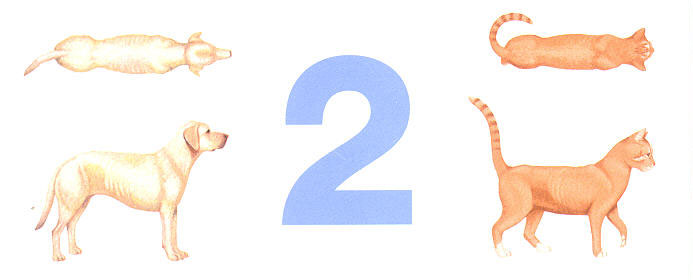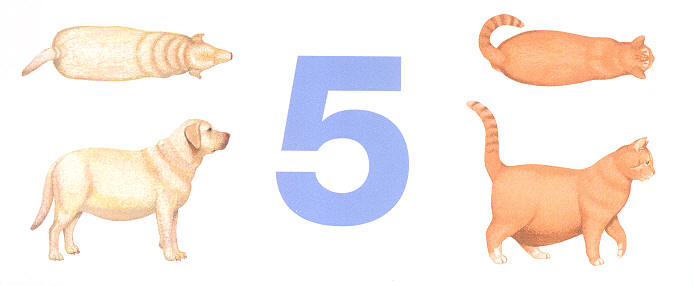
Introduction: Body condition scores (BCS) are used to identify the general condition of animals. In dogs, the grading system is based on the amount of fat found on the animal in certain areas. Each dog is given a body condition score (BCS) that ranges from a 1 (extremely thin/emaciated) to a 5 (extremely fat). Things such as nutrition, reproductive status, parasite load, performance demands, and disease problems can all influence the body condition of dogs. Body condition is often a more reliable indicator of the nutritional status than simply using body weights. Realize that dogs with identical weights, even of the same breed, may not have the same BCS.
Determining a Body Condition Score: When assigning a BCS to a dog, start by observing the dog from a few feet away. Also view the top of the dog while standing above its back. Look for general fat distribution and body proportions. It is important to remember that certain conditions such as pregnancy will greatly influence the general appearance of the dog.
After observing the dog from a distance, physically feel or palpate the rib cage region of the dog. For a dog in normal condition (a BCS of about a 3), the ribs and rib spaces should be easily felt, but not seen. Dogs that are a BCS of 4-5 will often have tissue and fat covering the ribs, making the ribs difficult to impossible to feel. Dogs that are a BCS of 1-2 will have ribs that are easily felt and can be seen. The back bone or spinus processes can also be seen and felt. Obviously, if the dog has a very thick coat, it will be difficult to actually see the ribs. In these cases, feeling the ribs will be the best way of determining BCS.
The following pictures show the typical body condition scores for dogs:
Body Condition Score of 1: These animals are extremely emaciated and thin. The ribs are easily felt and can be seen. The back bone or spinus processes can also be seen and felt and there is no fat cover.

Body Condition Score of 2: These animals are underweight and thin. The ribs are easily felt and can be seen. There is little fat cover and the pet has a marked hourglass shape when viewed from above.

Body Condition Score of 3: These animals are at an IDEAL body condition. The ribs are easily felt, but cannot be seen. They have a well-proportioned waist.

Body Condition Score of 4: These animals are considered overweight. The ribs are difficult to feel. There is also an extra amount of fat and tissue between the hind legs and under the abdomen.

Body Condition Score of 5: The pets in this category are considered obese. The ribs are difficult to impossible to feel. Fat often hangs from the abdomen and between the legs.
The pictures and some of the wording for the captions were used with permission from The Hillís pet food company.